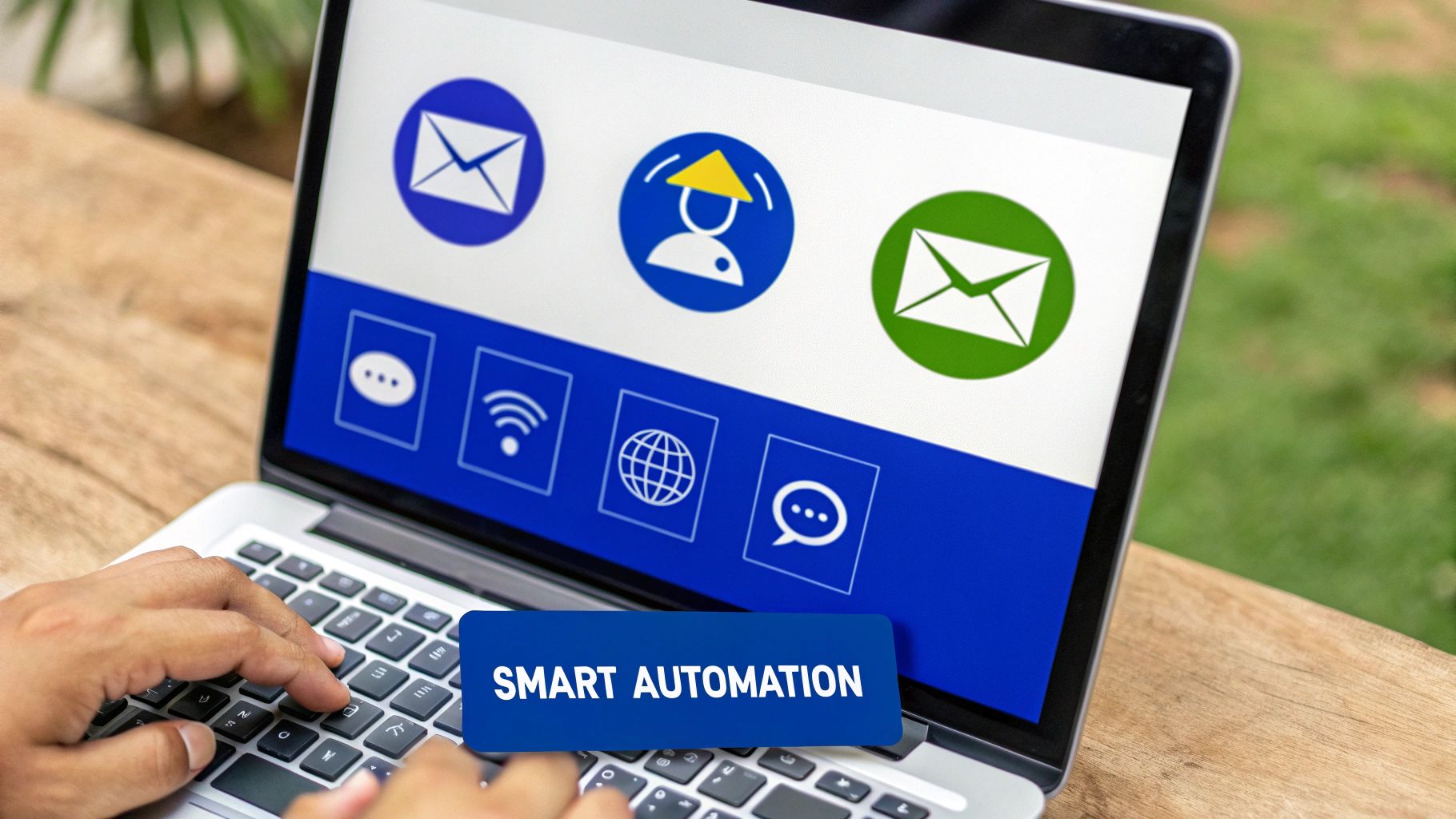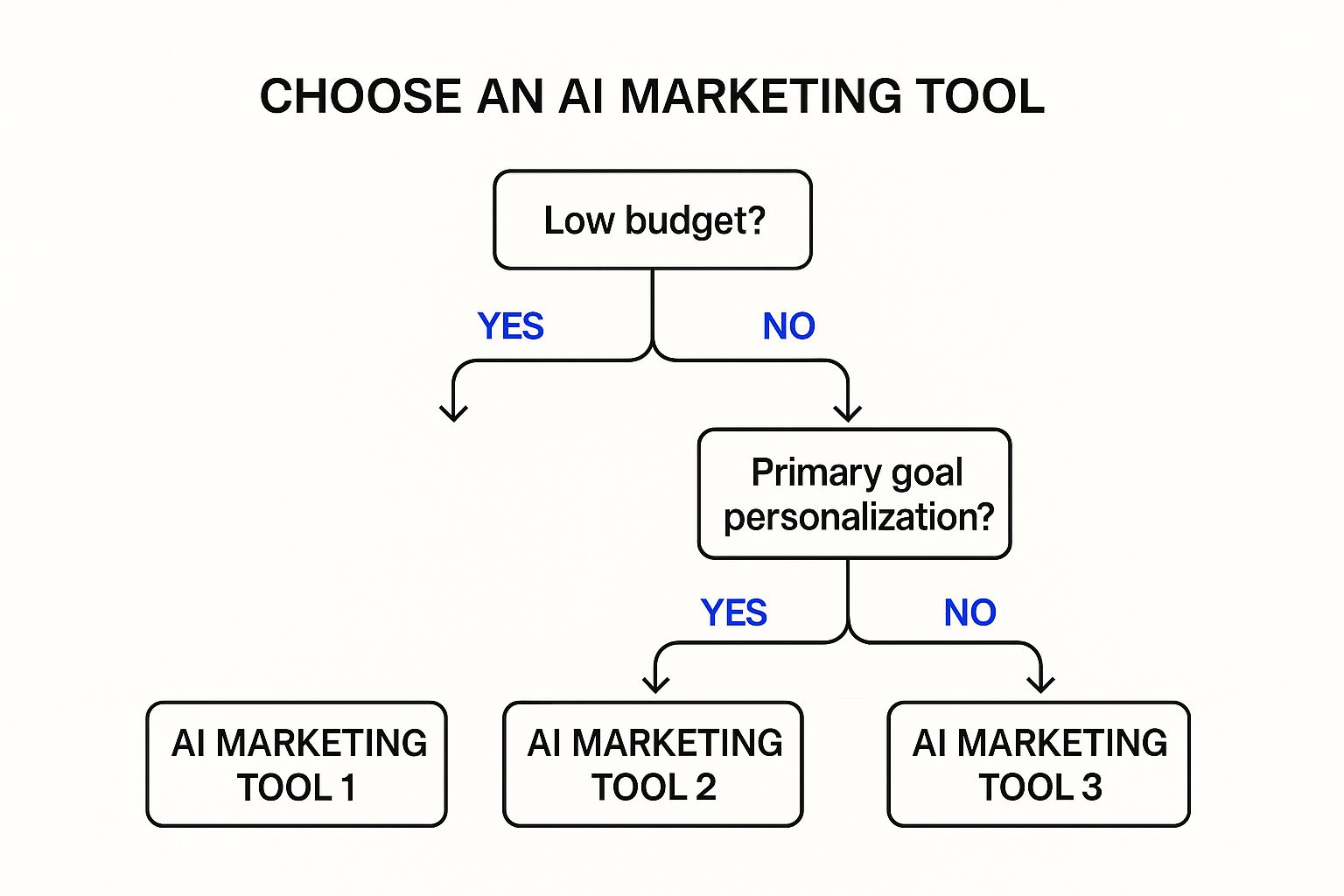Think of it this way: would you rather navigate a new city with a folded paper map or a real-time GPS? That's the leap from old-school marketing to marketing that uses AI. AI-powered marketing tools aren't just another piece of software; they are smart systems that automate tough tasks, figure out what customers want, and spot opportunities you might have missed. They help you switch from guessing to making choices based on real data.
The New Era of AI in Marketing
We've reached a turning point. Marketing isn't just about shouting your message to as many people as possible. It’s about connecting with individuals in a way that feels personal and genuine. For years, marketers relied on broad assumptions and slow, manual work—it was like trying to hear one person in a noisy stadium. It was slow, inefficient, and often wrong.
AI-powered marketing tools change everything. They act like a smart co-pilot, processing huge amounts of information in seconds. This isn't some sci-fi idea for the future. Moving from manual work to smart automation is the new standard for any business that wants to keep up.
From Manual Guesswork to Intelligent Decisions
The biggest change AI brings is the power to make smarter decisions, faster. Forget spending weeks digging through reports. AI gives you insights in real time, showing you what’s working and what’s not—right now. This means you can make quick adjustments that save money and improve your results on the fly.
This shift is driving serious growth. The global AI marketing market is expected to grow from $20 billion in 2022 to $40 billion by 2025, growing at about 20% each year. Industries like retail and finance are leading the way, using AI to make their marketing sharper and get ahead of the competition.
Unlocking Key Business Advantages
Using these tools gives you a clear edge. They allow businesses of any size to work with the same efficiency that used to be only for huge companies with big data science teams. For a great overview of the wider impact, check out the 8 ways AI is revolutionizing the e-commerce industry, which explains how it's changing everything from daily operations to the customer experience.
Let's quickly review the main benefits of adding AI to your marketing.
Key Benefits of AI Marketing Tools at a Glance
This table breaks down the main advantages businesses get when they start using AI-powered marketing solutions. It’s a quick snapshot of the value they bring.
As you can see, the impact isn't just about saving time—it's about getting smarter, more effective results everywhere.
Think of AI not as a replacement for marketers, but as a powerful partner. It handles the repetitive, data-heavy lifting, allowing human creativity and strategic thinking to shine.
This partnership is what modern marketing is all about. When you embrace AI, you’re not just installing new software. You’re building a smarter and more effective marketing engine for your business. To see how you can put these ideas into practice, take a look at our guide on essential AI tools for digital marketing.
How AI Is Reshaping Marketing Tasks

It’s time to look past the buzz and see how AI-powered marketing tools are actually changing the day-to-day work. This isn't a far-off concept anymore; AI is a hands-on tool that is overhauling how we create content, understand our audience, and run campaigns.
Think about how things used to be done. Brainstorming blog topics meant endless meetings and hoping an idea would stick. Segmenting an email list was a clunky, manual process that relied on broad, often old, demographic data. Today, that world looks completely different, all thanks to smart automation.
And this isn't just about doing things faster. AI improves the quality of our work, turning what were once repetitive chores into data-backed opportunities. It does the heavy lifting, freeing up marketers to focus on what humans do best: creativity, strategy, and building genuine connections.
Supercharging Content Creation
Content is the engine of modern marketing, but the demand for fresh, high-quality material is relentless. Before AI, a single blog post could take days of research, writing, and editing. Multiply that by all the different versions needed for social media, ads, and emails, and it becomes a massive time drain.
Now, AI tools are like having a powerful creative partner. Instead of staring at a blank page, you can generate dozens of good blog ideas in minutes. These tools can analyze what's already ranking on Google and suggest topics that have a real shot at bringing in traffic.
The possibilities don't stop there:
- Drafting Copy: AI can write initial drafts for ad copy, email subject lines, and social media captions, giving you a solid starting point to refine.
- Generating Visuals: Need a unique image for a blog post or an ad? AI image generators can create custom visuals from a simple text description. No more scrolling through endless stock photos.
- Optimizing for SEO: AI can review your content for keywords, readability, and structure, giving you clear suggestions to help it rank better.
This is especially true for social media, where things move incredibly fast. In fact, AI has become a key part of any actionable guide to social media marketing, showing businesses how to improve their strategies with new tech.
Gaining Deeper Audience Insights
You can't have good marketing without truly understanding your audience. The old-school methods—surveys, focus groups, and digging through past sales—were slow and only gave you a small piece of the puzzle. You could see what customers did, but rarely why.
AI marketing tools dig much deeper. They analyze huge sets of data in real time, uncovering hidden patterns and even predicting what customers will do next. It’s the difference between looking in the rearview mirror and having a GPS that shows you the road ahead.
By 2025, AI-powered marketing tools have transformed content creation, audience research, and campaign automation on a global scale. Generative AI technologies enable marketers to produce high-quality text, hyper-realistic images, and even videos, drastically reducing time and costs associated with content generation.
Take a platform like GWI Spark, for instance. It uses AI to analyze consumer data from nearly one million people across more than 50 markets, giving marketers truly unique and useful insights. You’re not just guessing anymore; you’re seeing exactly what motivates your customers.
Automating Campaign Management
Running a successful marketing campaign is a constant juggling act. You have ad budgets, channel choices, creative tests, and performance tracking all competing for your attention. Trying to manage all of that manually isn't just inefficient—it's almost impossible to get right.
AI brings a whole new level of precision. Instead of setting a budget and crossing your fingers, AI programs can adjust ad spending on the fly, automatically moving money to the ads and channels that are delivering the best results.
This smart automation changes how we handle several key tasks:
- Predictive Lead Scoring: AI analyzes a lead’s behavior to predict how likely they are to buy, letting sales teams focus their energy where it will have the biggest impact.
- A/B Testing at Scale: Instead of testing two ad versions, AI can create and test hundreds at once to find the absolute best combination of headline, image, and call-to-action.
- Personalized Customer Journeys: Based on how a user interacts with your brand, AI can trigger automated emails, show them personalized content on your website, or recommend products they'll actually want.
In the end, AI is reshaping marketing by turning reactive, manual tasks into proactive, automated strategies. It gives us the tools to create better content, understand our customers more deeply, and run campaigns with an intelligence and efficiency that just wasn't possible before.
Putting AI Tools into Action with Real Examples

It’s one thing to talk about what AI-powered marketing tools can do. It’s another to see how they’re actually making a difference for real businesses. The true "aha!" moment comes when you see how companies are using this tech to solve real problems and get better results.
And we're not just talking about huge corporations with unlimited budgets. Businesses of all sizes are using AI to be more competitive, turning raw data into smarter decisions and making automation their secret weapon.
Let’s walk through a few scenarios. Each one starts with a common marketing problem, shows how an AI tool was used to fix it, and ends with the kind of real results that make a difference. Think of these as a blueprint for what’s possible in your own marketing.
E-commerce Personalization That Boosts Sales
An online fashion store had a common problem: lots of people were visiting their site, but not enough were buying. Shoppers would click around, look at a few things, and then leave, probably overwhelmed by too many choices. The old, generic "you might also like" section wasn't working.
So, they added an AI-powered personalization engine. This wasn't a basic recommendation tool. It analyzed a visitor's entire journey in real time—what pages they viewed, how long they looked at an item, even their mouse movements—to figure out their personal style.
The change was immediate and impressive:
- Personalized Recommendations: That boring, generic product list was replaced with a dynamic feed of items that felt hand-picked for each shopper.
- Targeted Email Campaigns: The AI also handled their email follow-ups. If a user spent time looking at a specific pair of shoes, they’d get an email about those exact shoes, maybe with a small discount to encourage them to buy.
- Measurable Uplift: In just the first three months, the brand saw a 15% increase in its conversion rate. Even better, the average order value jumped by 25% because customers were adding more of the personally recommended items to their carts.
This is a perfect example of how AI can turn an anonymous visitor into a valued customer. The store stopped shouting at a crowd and started having a one-on-one conversation with each shopper.
B2B Lead Scoring for a More Efficient Sales Team
Now, let’s switch to a B2B software company. Their marketing team was doing great, bringing in a ton of leads from webinars and content downloads. The problem? The sales team was overwhelmed, wasting most of their day chasing people who were never going to buy.
They brought in an AI-driven lead scoring platform to act as a filter. The tool connected to their CRM and started analyzing dozens of data points for every new lead—job title, company size, website activity, and email engagement.
The platform then assigned a simple predictive score, ranking each lead from "hot" to "cold." The new rule for the sales team was simple: only reach out to leads who scored above a certain number.
This simple change meant the sales team could stop wasting time on dead-end leads. Instead, they focused all their energy on building relationships with people who were actually ready to talk. The AI became their smart gatekeeper, only letting the best opportunities through.
The impact on efficiency was huge. The average sales cycle got 18% shorter, and the lead-to-customer conversion rate shot up by 30%. It was a win for marketing, too. They used the AI’s insights to see which channels were delivering high-quality leads and adjusted their ad spending to match.
Want to see more of this in action? You can dig into some case studies on successful AI-driven marketing campaigns to see how it all comes together.
Automating Content for Niche Markets
Imagine a small travel agency specializing in eco-tourism. They wanted to grow, but their small team couldn't create unique content for every single niche destination they offered. Writing blog posts, social updates, and email newsletters for dozens of different trips was impossible.
They turned to a suite of AI-powered marketing tools to handle the heavy lifting. They used generative AI to produce first drafts of blog posts for specific destinations, which a human editor would then polish with the brand's unique voice. They also used AI to create dozens of ad copy variations for different audiences.
This strategy let them scale their content output without hiring more people. Suddenly, they could create targeted content that spoke directly to travelers interested in everything from Costa Rican rainforests to Norwegian fjords. For a closer look at how AI can power these kinds of strategies, check out these advanced marketing automation workflow examples. The result was a big boost in their website traffic and, most importantly, a steady stream of new leads.
How To Choose The Right AI Marketing Tools
Picking the right AI-powered marketing tools can feel like choosing one dish from a ten-page menu. With so many options, each promising amazing results, it’s easy to get overwhelmed. But here's the secret: the goal isn't to find a perfect tool, but to find the right tool for your business, your team, and your budget.
Jumping on the trendiest platform without a clear plan is a recipe for wasted money and frustration. A smart choice comes down to asking a few simple questions first. Think of it as a checklist to make sure you're investing in a solution that will actually help you grow.
Start With Your Core Needs
Before you even look at a feature list, take a hard look at your own work. Where are the biggest bottlenecks in your marketing? Are you spending too much time on repetitive tasks? Do you struggle to make sense of your campaign data? Your biggest headache is the best place to start looking for a solution.
Once you’ve identified the problem, you can start looking at your options. Ask yourself these key questions:
- Integration Power: Does this tool work with the software you already use every day? A powerful AI tool that can't connect to your CRM will just create more manual work. Smooth integration is a must.
- Scalability: Will this tool still be a good fit in a year? A solution that's perfect for a small startup might not handle a rapidly growing customer base. Look for a platform that can grow with you.
- User-Friendliness: Can your team actually use it without a giant instruction manual? The most advanced AI is useless if it's too complicated. A clean, simple interface means your team can get started and see value right away.
The All-in-One Advantage
As you look around, you'll face a common choice: should you get several specialized tools or one platform that does it all? Juggling multiple, disconnected tools often leads to data getting trapped and a workflow that feels clunky. This is where all-in-one platforms like Markopolo really shine by simplifying your entire marketing setup.
By bringing ad creation, social media management, and deep analytics together under one roof, you get a single, unified system. This approach not only makes your daily tasks easier but also gives you a much clearer, more complete picture of your customer's journey. For a deeper dive into this integrated approach, check out this excellent non-technical guide to autonomous marketing platforms that breaks down the benefits.
This decision tree gives you a simple way to start thinking about your choice based on your budget and main goals.

As the visual shows, there isn't one "best" tool for everyone. The right path depends on your main goals and what you can invest.
Evaluation Checklist for AI Marketing Software
To make the decision process even more concrete, we've put together a practical checklist. Use this table to compare different tools side-by-side and make sure you're covering all the important bases for your business.
This checklist isn't about finding a tool that scores perfectly on every point. It’s about finding the one that aligns best with what you’ve marked as "High" importance.
Making A Confident Decision
Ultimately, choosing the right AI marketing tool is a strategic move. It requires a clear understanding of your business goals and an honest look at your team's needs. Don't get distracted by flashy features you'll never actually use.
A study by Harvard Business Review found that 73% of organizations struggle with technology adoption because they lack a clear strategy and proper user training. The best tool is one that empowers your team, not overwhelms them.
Focus on finding a solution that solves a real problem, fits into your existing workflow, and delivers clear, useful insights. When you prioritize these practical needs over industry hype, you can confidently pick a tool that will become a true partner in your growth. Remember, the goal is to make your marketing smarter, not just more complicated.
Navigating Common AI Implementation Hurdles

Rolling out new tech, especially something as big as AI, isn't as simple as flipping a switch. You're likely to hit a few snags, from technical issues to getting your team on board. Knowing what to expect is half the battle when you're bringing AI-powered marketing tools into your work.
Think of these hurdles less as roadblocks and more as signs showing you where to focus your energy. If you plan for them, you can bring AI into your workflow smoothly, ethically, and with your entire team feeling confident instead of worried. Let's break down the common challenges and how to handle them.
Managing The Human Element
Often, the biggest obstacle isn't the software—it's the people. It's natural for team members to feel a bit intimidated by new tools or worry about their roles changing. Addressing this concern head-on is crucial for a successful rollout.
The key is clear communication and good, hands-on training. Don't just announce a new platform. Explain why you're adopting it and, more importantly, how it will make their jobs easier, not get rid of them. Frame it as a way to ditch the boring tasks so they can focus their energy on more creative and strategic work.
"Your job will not be taken by AI. It will be taken by a person who knows how to use AI."
This gets right to the heart of it. AI is a tool, not a replacement. Learning to work with these systems is a powerful new skill that makes everyone more valuable. When you provide proper training and support, you turn that uncertainty into empowerment, and you'll get everyone working together.
Ensuring Data Privacy and Security
AI models need a lot of data, which naturally raises big questions about privacy and security. Handling customer information correctly isn't optional—it's a requirement. You need to be crystal clear about what data you're collecting and how your AI is using it to make their experience better.
Start by picking tools from reputable companies that follow regulations like GDPR and CCPA. From there, you need clear internal rules for how data is managed. Here are a few practical steps to take:
- Anonymize Data: Whenever you can, remove personal details from the data used to train your models. This protects individual privacy while still allowing the AI to learn.
- Conduct Regular Audits: Set a schedule to review your AI tools and data practices. This ensures you're always following the latest privacy laws and best practices.
- Be Transparent: Explain your data policies to your customers. Building trust starts with showing them you respect their privacy.
Avoiding Robotic Content And Over-Reliance
Let's be honest—a common fear with AI content is that it sounds like a robot wrote it. It can feel generic and lack that human spark that actually connects with people. While AI is a fantastic starting point for drafts and ideas, it should never be the final voice of your brand.
The fix? A "human-in-the-loop" workflow. Let the AI do the heavy lifting—maybe 80% of the content creation—but always have a human editor handle the final 20%. Their job is to polish the text, add nuance, and make sure it sounds exactly like your brand.
This hybrid approach is quickly becoming the standard. By 2025, AI is expected to be a normal part of marketing, with 88% of marketers already using it in their day-to-day work. The most common use? Content optimization. Over half (51%) of marketing teams worldwide use it for things like adding SEO keywords and tweaking messages for better engagement. You can explore more statistics about AI's role in marketing to get the full picture.
Setting clear goals also keeps you from leaning too heavily on automation. Define exactly what you want the AI to do. Maybe it's boosting lead generation by 15% or cutting down social media scheduling time by five hours a week. Specific targets keep your strategy sharp and ensure AI serves your goals, not the other way around.
Frequently Asked Questions About AI Marketing
Diving into AI marketing can bring up a lot of questions. Let's clear up a few of the most common ones so you can move forward with confidence.
What are AI-powered marketing tools?
AI-powered marketing tools are smart software designed to make marketing more effective and efficient. They use artificial intelligence to analyze data, find patterns, predict customer behavior, and automate tasks like writing ad copy or managing social media. Think of them as an intelligent assistant for your marketing team that handles the heavy lifting, freeing you up to focus on strategy and creativity.
How can small businesses benefit from AI marketing?
AI marketing tools are a game-changer for small businesses. They help level the playing field against larger competitors by automating time-consuming tasks and providing deep customer insights without needing a big team. This allows small businesses to save money, improve their campaign results, and deliver personalized experiences that were once only possible for big companies. A small ecommerce shop, for example, can use AI to recommend products just as effectively as a major online retailer.
Will AI take over marketing jobs?
No, AI is not expected to take over marketing jobs. Instead, it will change them. AI is great at handling repetitive, data-heavy tasks, which frees up marketers to focus on what humans do best: strategy, creative thinking, and building relationships. Marketers who learn how to use AI will become more effective and valuable, using these tools to achieve better results. AI is a partner, not a replacement.
What is a good first step to start using AI in marketing?
The best way to start is to begin small. Identify one of your biggest marketing challenges, whether it's creating content, managing social media, or analyzing ad performance. Then, find an AI tool designed to solve that specific problem. Many platforms offer free trials, which let you test the technology without a big commitment. Start by using the tool for a single, small task, like generating headlines for a blog post, to see the benefits for yourself and get comfortable with how it works.
Ready to see what a unified AI marketing platform can do for your business? Start your journey toward smarter, more effective marketing today.







.jpg)
.png)
.png)



